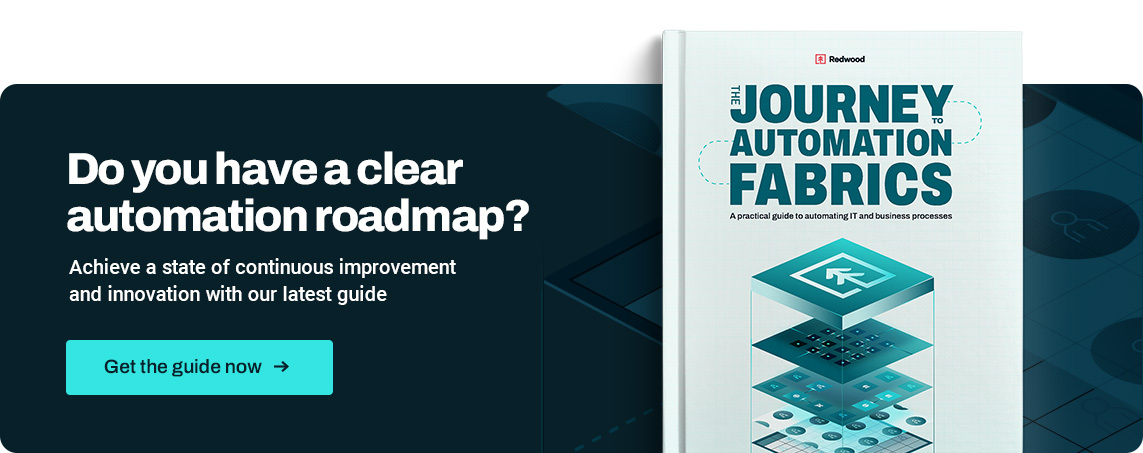Weaving the future of automation: The rise of automation fabrics

For the last fifteen years, the enterprise software industry has revolutionized our ability to weave an interconnected and intelligent architecture that enables organizations to seamlessly connect, manage and govern their data.
As the former CEO of one of the enterprise software leaders in analytics, I had a front-row seat to this “data fabric” revolution. While it was easy to get caught up in the marketing hype around new terms like “big data” and “predictive analytics,” the reality was that the most competitive companies in the world were increasingly differentiating their ability to serve their customers based on how well they collected, managed and utilized their data. By eliminating data silos, these leaders were able to consolidate and organize data from multiple sources and capture a unified view of the customer across all touchpoints.
The inevitable domino effect
Today, the use cases and benefits of a modern data fabric architecture are apparent. And now, this revolutionary interwoven approach is happening in the automation industry. The result of this will be a requirement for every modern enterprise to build “automation fabrics” in order to effectively compete and profitably grow.
An automation fabric is a cohesive and integrated framework that seamlessly connects various automation tools, processes and data sources. It acts as a central nervous system, enabling seamless communication and collaboration among disparate business activities, applications and environments, driving mission-critical business processes across any tech stack. Think things like procure-to-pay, just-in-time delivery, record-to-report.
The core market change driving this revolution and the need for automation fabrics isn’t rocket science. It’s simply a number of market shifts that we have all been investing in for some time. For starters, IT is no longer relegated to being a simple enabler of the back office. Lines of business leaders expect their technology investments to drive core business outcomes, with delivering a superior customer and employee experience being the new competitive battleground. For example, how do I close the books in record time? How do I translate an online order into cash collections without error? Or, how do I massively improve the resilience of my supply chain? Each of these business outcomes starts with some kind of end-to-end business process transformation.
However, achieving that end-to-end business process transformation is now quite complicated. As best-of-breed products replaced business suites for more superior, targeted functionality, the number of applications that house these business processes, and their underlying transaction data, has absolutely exploded over the last two decades.
The good news is these highly specialized, process-oriented applications have made many individual tasks easier and more forgettable. But the bad news is they’ve created an endless sea of silos that do everything incredibly efficiently alone but do virtually nothing together. Today, almost no business outcome — including mission-critical ones — is accomplished with just one application. Furthermore, most mission-critical business outcomes still require working with established transaction systems of record, like your ERP system. As a result, the transaction data and business processes needed to come together to drive these business outcomes require coordination across multiple applications — cloud, on-premises or hybrid — working in an orchestrated fashion.
To make things more complex, all these bespoke applications and systems often run on tech infrastructure that is constantly changing. Enterprise modernization efforts are no longer just considering a simple lift and shift from on-premises to the cloud. Instead, leaders are conducting a careful reassessment and refactoring of their entire tech stack, as they are on a mission to tear down monolithic systems and refactor their vast tech stacks to microservices architectures while putting everything into containers, including modernizing their CI/CD and DevOps pipelines for faster delivery.
When companies start refactoring their entire tech stack into microservices and containers spinning up and down on this massive a scale, you need an immense amount of automation because human beings cannot handle this manually — it’s an n-dimensional problem. This great replatforming has created a real problem for enterprises, as their legacy automation platforms simply do not have the ability to automate business processes end to end across this full stack of mission-critical applications and underlying, ever-changing tech infrastructure. This n-dimensional complexity requires a new approach to automation. One that’s purpose-built for a best-of-breed application world but also provides the flexibility to work across any IT infrastructure you may encounter. It’s why automation will become the pervasive operation system fabric powering today’s modern enterprises.
Choose your partner wisely
In the same way data fabrics revolutionized our ability to make more informed decisions for our companies, customers and employees, automation fabrics will now revolutionize our ability to deliver superior customer and employee experiences. Like building data fabrics, building your automation fabric requires making critical decisions around your automation platform and software partner. After all, your automation fabric will be the pervasive operation system driving your entire company. So, it’s an important decision! Some points you may want to consider in choosing your automation partner include:
- Connecting applications and systems: Can I connect deeply to all the applications and systems I need to connect to ensure seamless, end-to-end business process automation? Does this include connections to my ERP system and my SaaS and legacy applications?
- Composability: Can I create new automations quickly and at scale without extensive programming resources? Can I easily create a new automation with a drag-and-drop approach and pre-built components rather than creating code?
- Monitoring and control: Can I monitor and control the myriad of processes in real time and have confidence that the processes will run to completion? Can I predict, manage and take action on SLA performance?
- Confidence: How confident am I in the platform’s ability to scale its performance in a highly secure manner? Does it come with global 24/7 support?
Harness the power of automation
You will hear a lot of buzz around enterprise businesses turning their attention to the automation fabric. But in its essence, it’s simply about tying every mission-critical business process together into a seamlessly orchestrated effort. And at its core, it’s about freeing up the time and mind space for you and your team to focus on the bigger picture and more strategic initiatives that will drive your business forward. You just need the time and space to see the forest! Your automation fabric will help you do just that.

About The Author

Kevin Greene
Kevin Greene brings more than 25 years of enterprise software leadership experience as an operator, board member, investor, and investment banker working with breakthrough technology companies. Prior to joining Redwood, Kevin was the CEO of Logi Analytics, a private equity-backed enterprise software company and leader in embedded analytics, which successfully exited to insightsoftware in April of 2021. Kevin has also served as a Partner at Valhalla Partners, a $440 million venture capital firm in Virginia. He was also a principal at Flagship Ventures, an early-stage venture capital firm in Massachusetts. Prior to Kevin’s venture career, he held both director-level and product marketing roles at IBM. Kevin started his career at Goldman Sachs in its New York and Hong Kong offices.
Kevin has an MBA from the Harvard Business School. He earned a Bachelor of Science in Finance and Marketing from the University of Virginia’s McIntire School of Commerce where he also captained the Virginia varsity swimming team.